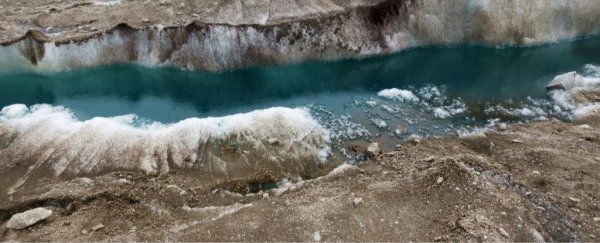Trapped within the Arctic permafrost there's a whole lot of carbon - potentially up to four times more carbon than the combined amount of CO2 modern humans have emitted.
It's one of the reasons scientists are so worried about the Arctic melting - as the ice goes, this carbon will be released. But now a new study has shown that a melting Arctic may actually unleash far more carbon than even our worst-case models have predicted.
This is because hungry microbes, hiding in the Arctic soil, seem to be chewing their way through tiny molecular iron manacles that would otherwise be shackling carbon to the soil - meaning we've underestimated the risk of it being released into the atmosphere.
These iron-reducing bacteria are becoming activated by rising temperatures, and they may be making the whole carbon sink a lot more unstable.
The discovery was confirmed in a single bog in northern Sweden, though their results reflect conditions that are considerably widespread. With the findings so new to science, they are promising to change how we view our current climate models.
If bacteria is truly undermining iron's carbon-trapping powers throughout the Arctic, researchers warn melting permafrost could unearth far more carbon emissions than even our worst-case-scenarios bargained for.
The amount of extra carbon that could be released, currently trapped and bound by iron, could equal up to five percent of all the carbon already in our atmosphere, the team says - that's five times as much as humans pump into the atmosphere each year.
"This means that we have a large new source of CO2 emissions that needs to be included in climate models and more closely examined," says Carsten W. Müller, who studies soil organic matter at the University of Copenhagen.
Knowing what's going on underfoot in the Arctic is crucial when permafrost stores as much carbon as all the plants in the world and all the carbon in the atmosphere combined.
To that end, an international team of researchers collected three core soil samples over three years in the Stordalen mire of Abisko, Sweden.
What they found was ultimately discouraging. While iron was shown to bind organic carbon in peat mounds on top of permanently frozen permafrost, when this key layer melts, so too does the abundance of carbon sequesters.
As these soil microbes feed, they break the bonds between carbon and iron, releasing the greenhouse gas from the sink into the atmosphere
"Frozen soil has a high oxygen content, which keeps iron minerals stable and allows carbon to bind to them," explains Müller.
"But as soon as the ice melts and turns to water, oxygen levels drop and the iron becomes unstable. At the same time, the melted ice permits access to bacteria. As a whole, this is what releases stored carbon as CO2."
Interestingly, the team noticed hints that deeper parts of the soil might contain a higher number of carbon-trapping iron oxides, and this suggests that as the sink collapses, more carbon is set to be released.
"The majority of climate research in the Arctic focuses on the amount of stored carbon and how sensitive it is to climate change. There is a great deal less of a focus on the deeper mechanisms which trap carbon in soil," says Müller.
This research is important, because the exact ways in which iron impacts Arctic permafrost is still largely unknown. While the mineral is thought to be important for carbon storage, it's unclear how this process will respond to rapid permafrost thaw and changing soil conditions. In fact, these are considered some of the greatest uncertainties in our climate predictions to date.
As plants spread across thawing tundra, for instance, their expanding root systems could very well activate microbial production of carbon four fold, possibly priming the ground for further melt.
Future research should hone in on these harder-to-see mechanisms. Further study might also consider methane storage, which is an even more potent greenhouse gas trapped in permafrost that could be impacted by changing microbial activities as well.
The number of unknowns hidden beneath our feet is truly terrifying.
The study was published in Nature Communications.
